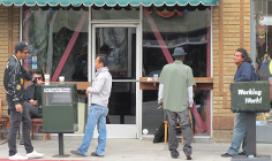Reformulating Cities Using People-Centric Design
Living in a modern city has its perks: Bijou cafes with al fresco dining, shopping centers within walking distance of your home, green spaces where friends and neighbors meet, and even car-free zones where pedestrians rule.
These aren’t just nice-to-haves. People-centric design can have real, positive impacts on a city’s residents.
“Things like residential density, intersection density, public transport density, and number of parks, these physical elements can invite a certain type of behavior: Up to about 90 minutes more physical activity,” said Jeff Risom, partner and managing director of Gehl Studio in the U.S. and the latest speaker in Volpe’s Future of Transportation series.
In addition to increasing activity, people-centric design can improve residents’ socioeconomic status, Risom said.
“Where we live, the quality of those neighborhoods can increase the probability of people from lower income groups moving up to higher income segments throughout their life,” Risom said.
To achieve people-centric design, planners need to know what residents like and don’t like about their cities, Risom said. But inherent in the traditional public engagement meeting is the problem that residents who go to them tend to be particularly vocal and do not represent an entire city.
“In terms of engagement, we believe the key is to go out and meet people where they are as part of their everyday routine,” Risom said.
Success Stories
Times Square in New York
For decades, Times Square was a misnomer: There was no square in Times Square. Nearly 90 percent of the space was used for roads, while 90 percent of the users of Times Square were pedestrians, Risom said. This mismatch between space and usage led New York to create a permanent pedestrian plaza in 2010.
“Times Square is actually just one of over 70 new plazas that New York City has created since 2008,” Risom said. “Seventeen acres of new space following this very easy concept: when you have a traffic island, you can close a small piece of road and connect it to a sidewalk and create a new public space.”
16th Street Mall in Denver
The 16th Street Mall is a 1.25-mile-long pedestrian, transit, and retail district in downtown Denver. From a transportation perspective, it is a success, with 55,000 people taking a dedicated 16th Street Mall bus every day. By other metrics, it has fallen behind increased demand for shared public spaces.
“There was a lot of antisocial behavior and the retail environment was underperforming, so we’ve been working with the city,” Risom said. “Let’s see what happens when we reroute the buses. Let’s see if we can get a win-win situation by allowing 16th Street to serve a different function.”
Over several weekend trials, Denver rerouted the buses and closed the mall to vehicle traffic. Risom and his team found that during these trial periods, there was 1.5 times more commercial activity, and the number of people who felt strongly positive about the mall went up 200 percent.
Three Big Paradigm Shifts in Thinking About City Design
Climate Change and Quality of Life
The major long-term benefit of reducing carbon emissions from transportation is quelling climate change. There are also numerous co-benefits related to quality of life that come with solutions that reduce climate change—like making a city attractive, stimulating business, and improving public health.
“People like the co-benefits,” Risom said. “What if we gave people lots of benefits, and the co-benefit was the carbon reduction?”
Jurisdictions and Places
Pedestrians, drivers, and bicyclists experience a street as a holistic entity. Yet a single street in the U.S. might have numerous agencies that can claim ownership over it. A planning department might be in charge of a sidewalk. A transportation department might be in charge of the road. A parks department might be in charge of green space on the other side of the street.
“The street is probably our most prized public asset,” Risom said. “Can streets actually be the great equalizer to address some of the issues we have in society? If so, it would demand for us to take off our different departmental heads and begin to talk about how we collaborate.”
Connecting People to Opportunity
Achieving people-centric design requires big ideas from everyone. Cities that do not include a large portion of their population as constructive partners miss out on innovative ideas.
“It’s not about just building a park—it’s about creating a space where people can spend time outside and build social connections,” Risom said. “It’s about bringing in many other institutions and backgrounds.”

